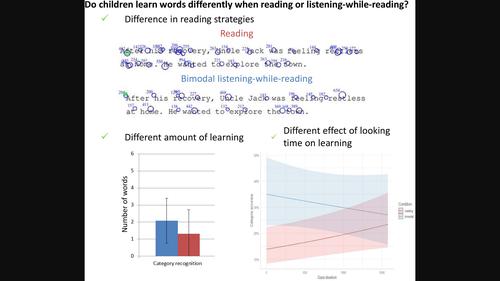在线处理显示边听边读双模式在词汇学习中的优势:眼动跟踪研究
IF 4.1
1区 教育学
Q1 EDUCATION & EDUCATIONAL RESEARCH
引用次数: 1
摘要
儿童可以从故事中附带学习单词。如果故事同时以听觉和书面形式呈现,这种学习效果会比只以书面形式呈现更好。然而,我们并不知道为什么这种双模式的呈现方式会带来益处。本研究探讨了两种可能的解释:双模态优势是在接触故事时在线表现出来,还是在之后的单词检索中表现出来。我们收集了 34 名 8 至 9 岁儿童的眼动数据,这些儿童接触了两个故事,一个故事以书面形式呈现(阅读条件),另一个故事以听觉和书面形式同时呈现(双模态条件)。每个故事包括重复出现三次的六个陌生单词(非单词),以及单词的定义和含义线索。接触后,对学习新单词含义的情况进行评估。结果显示,与阅读条件相比,在故事呈现过程中,儿童在双模态条件下固定新单词的时间更少,这表明双模态优势是在线产生的。双模态条件下的学习效果比阅读条件下的学习效果好,这可能反映了故事呈现过程中的在线双模态优势或检索时的优势。研究结果还表明,当儿童观察新单词的时间较短时,双模态条件比阅读条件更有利于学习。这与双模态条件的在线优势相一致,因为它表明在这种条件下学习单词所需的努力更少。这些结果支持同时以两种模式呈现新词汇的常规教育策略。本文章由计算机程序翻译,如有差异,请以英文原文为准。

Online Processing Shows Advantages of Bimodal Listening-While-Reading for Vocabulary Learning: An Eye-Tracking Study
Children can learn words incidentally from stories. This kind of learning is enhanced when stories are presented both aurally and in written format, compared to just a written presentation. However, we do not know why this bimodal presentation is beneficial. This study explores two possible explanations: whether the bimodal advantage manifests online during story exposure, or later, at word retrieval. We collected eye-movement data from 34 8-to 9-year-old children exposed to two stories, one presented in written format (reading condition), and the second presented aurally and written at the same time (bimodal condition). Each story included six unfamiliar words (non-words) that were repeated three times, as well as definitions and clues to their meaning. Following exposure, the learning of the new words' meanings was assessed. Results showed that, during story presentation, children spent less time fixating the new words in the bimodal condition, compared to the reading condition, indicating that the bimodal advantage occurs online. Learning was greater in the bimodal condition than the reading condition, which may reflect either an online bimodal advantage during story presentation or an advantage at retrieval. The results also suggest that the bimodal condition was more conducive to learning than the reading condition when children looked at the new words for a shorter amount of time. This is in line with an online advantage of the bimodal condition, as it suggests that less effort is required to learn words in this condition. These results support educational strategies that routinely present new vocabulary in two modalities simultaneously.
求助全文
通过发布文献求助,成功后即可免费获取论文全文。
去求助
来源期刊

Reading Research Quarterly
Multiple-
CiteScore
10.50
自引率
4.80%
发文量
32
期刊介绍:
For more than 40 years, Reading Research Quarterly has been essential reading for those committed to scholarship on literacy among learners of all ages. The leading research journal in the field, each issue of RRQ includes •Reports of important studies •Multidisciplinary research •Various modes of investigation •Diverse viewpoints on literacy practices, teaching, and learning
 求助内容:
求助内容: 应助结果提醒方式:
应助结果提醒方式:


